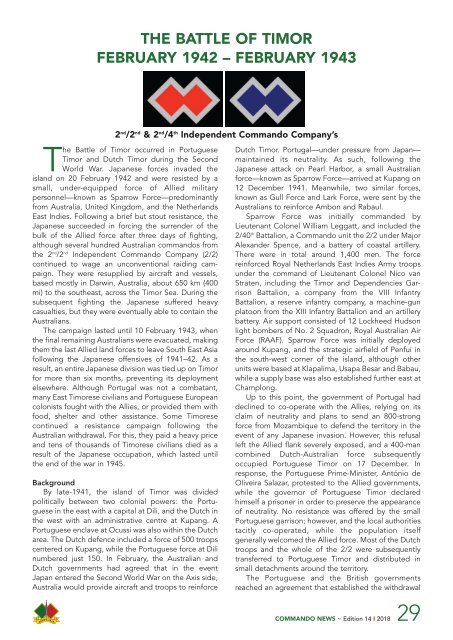You also want an ePaper? Increase the reach of your titles
YUMPU automatically turns print PDFs into web optimized ePapers that Google loves.
THE BATTLE OF TIMOR<br />
FEBRUARY 1942 – FEBRUARY 1943<br />
2 nd /2 nd & 2 nd /4 th Independent <strong>Commando</strong> Company’s<br />
The Battle of Timor occurred in Portuguese<br />
Timor and Dutch Timor during the Second<br />
World War. Japanese forces invaded the<br />
island on 20 February 1942 and were resisted by a<br />
small, under-equipped force of Allied military<br />
personnel—known as Sparrow Force—predominantly<br />
from <strong>Australia</strong>, United Kingdom, and the Netherlands<br />
East Indies. Following a brief but stout resistance, the<br />
Japanese succeeded in forcing the surrender of the<br />
bulk of the Allied force after three days of fighting,<br />
although several hundred <strong>Australia</strong>n commandos from<br />
the 2 nd /2 nd Independent <strong>Commando</strong> Company (2/2)<br />
continued to wage an unconventional raiding cam -<br />
paign. They were resupplied by aircraft and vessels,<br />
based mostly in Darwin, <strong>Australia</strong>, about 650 km (400<br />
mi) to the southeast, across the Timor Sea. During the<br />
subsequent fighting the Japanese suffered heavy<br />
casualties, but they were eventually able to contain the<br />
<strong>Australia</strong>ns.<br />
The campaign lasted until 10 February 1943, when<br />
the final remaining <strong>Australia</strong>ns were evacuated, making<br />
them the last Allied land forces to leave South East Asia<br />
following the Japanese offensives of 1941–42. As a<br />
result, an entire Japanese division was tied up on Timor<br />
for more than six months, preventing its deployment<br />
elsewhere. Although Portugal was not a combatant,<br />
many East Timorese civilians and Portuguese European<br />
colonists fought with the Allies, or provided them with<br />
food, shelter and other assistance. Some Timorese<br />
continued a resistance campaign following the<br />
<strong>Australia</strong>n withdrawal. For this, they paid a heavy price<br />
and tens of thousands of Timorese civilians died as a<br />
result of the Japanese occupation, which lasted until<br />
the end of the war in 1945.<br />
Background<br />
By late-1941, the island of Timor was divided<br />
politically between two colonial powers: the Portu -<br />
guese in the east with a capital at Dili, and the Dutch in<br />
the west with an administrative centre at Kupang. A<br />
Portuguese enclave at Ocussi was also within the Dutch<br />
area. The Dutch defence included a force of 500 troops<br />
centered on Kupang, while the Portuguese force at Dili<br />
numbered just 150. In February, the <strong>Australia</strong>n and<br />
Dutch governments had agreed that in the event<br />
Japan entered the Second World War on the Axis side,<br />
<strong>Australia</strong> would provide aircraft and troops to reinforce<br />
Dutch Timor. Portugal—under pressure from Japan—<br />
maintained its neutrality. As such, following the<br />
Japanese attack on Pearl Harbor, a small <strong>Australia</strong>n<br />
force—known as Sparrow Force—arrived at Kupang on<br />
12 December 1941. Meanwhile, two similar forces,<br />
known as Gull Force and Lark Force, were sent by the<br />
<strong>Australia</strong>ns to reinforce Ambon and Rabaul.<br />
Sparrow Force was initially commanded by<br />
Lieutenant Colonel William Leggatt, and included the<br />
2/40 th Battalion, a <strong>Commando</strong> unit the 2/2 under Major<br />
Alexander Spence, and a battery of coastal artillery.<br />
There were in total around 1,400 men. The force<br />
reinforced Royal Netherlands East Indies Army troops<br />
under the command of Lieutenant Colonel Nico van<br />
Straten, including the Timor and Dependencies Gar -<br />
rison Battalion, a company from the VIII Infantry<br />
Battalion, a reserve infantry company, a machine-gun<br />
platoon from the XIII Infantry Battalion and an artillery<br />
battery. Air support consisted of 12 Lockheed Hudson<br />
light bombers of No. 2 Squadron, Royal <strong>Australia</strong>n Air<br />
Force (RAAF). Sparrow Force was initially deployed<br />
around Kupang, and the strategic airfield of Penfui in<br />
the south-west corner of the island, although other<br />
units were based at Klapalima, Usapa Besar and Babau,<br />
while a supply base was also established further east at<br />
Champlong.<br />
Up to this point, the government of Portugal had<br />
declined to co-operate with the Allies, relying on its<br />
claim of neutrality and plans to send an 800-strong<br />
force from Mozambique to defend the territory in the<br />
event of any Japanese invasion. However, this refusal<br />
left the Allied flank severely exposed, and a 400-man<br />
combined Dutch-<strong>Australia</strong>n force subsequently<br />
occupied Portuguese Timor on 17 December. In<br />
response, the Portuguese Prime-Minister, António de<br />
Oliveira Salazar, protested to the Allied governments,<br />
while the governor of Portuguese Timor declared<br />
himself a prisoner in order to preserve the appearance<br />
of neutrality. No resistance was offered by the small<br />
Portuguese garrison; however, and the local authorities<br />
tacitly co-operated, while the population itself<br />
generally welcomed the Allied force. Most of the Dutch<br />
troops and the whole of the 2/2 were subsequently<br />
transferred to Portuguese Timor and distributed in<br />
small detachments around the territory.<br />
The Portuguese and the British governments<br />
reached an agreement that established the withdrawal<br />
COMMANDO NEWS ~ <strong>Edition</strong> <strong>14</strong> I <strong>2018</strong> 29

















